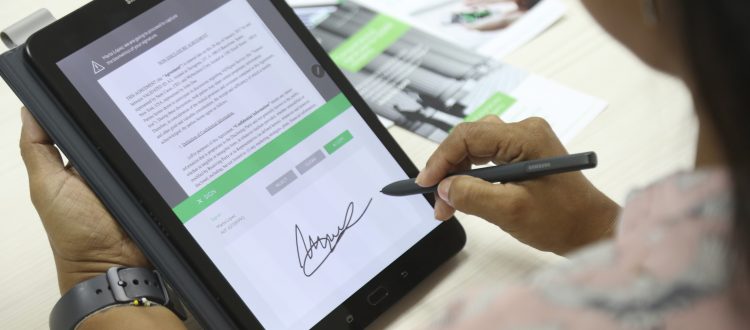- October 19, 2021
- Posted by: Techsol Life Sciences
- Category: Clinical Trials

Industry Background of eConsent
In an attempt to address health authority concerns and improve patient confidence, companies and independent industry bodies have experimented with electronic consent (eConsent) using electronic media such as smartphones, laptops, and tablets. Despite positive outcomes, its implementation remained experimental until FDA officially released a guidance in December 2016. Following in FDA’s footsteps, EMA collaborated with the European CRO Federation (EUCROF) and rolled out its own guidance in March 2021. [1] [2]
With official guidelines available, companies will still require to interpret the guidance properly, understand the study suitability, weigh in the value derivation for patients and be prepared for potential barriers in its implementation. Read on as we discuss all these aspects and also provide Techsol’s expert thought leadership for current and future scope for eConsent.
Value of implementing eConsent in Clinical Studies
Through digitalization, the eConsent process is projected to assist subjects to make informed decisions using multiple multimedia resources, and improve quality of the study by enhancing patient experience, data quality and electronic system. Primarily centered on improving patient experience and their understanding of trial process, implementing eConsent can be advantageous for the sponsors too. In terms of value derivation, implementing eConsent –
Contact us by submitting a business inquiry online. We will get back to you very soon.
- Allows trial investigators to make dynamic changes to consent data and protocol amendments while keeping the patients informed through instant electronic updates.
- Helps increase the process efficiency by simplifying the consent communication.
- Provides the sponsors regular insights into consent activities.
- Ultimately results in a higher patient retention rate and compliance.
How eConsent can be implemented for Clinical Development
a. Phase-wise considerations for implementing eConsent
Executing eConsent is far more complex and critical than simply operating multimedia components. Sponsors/CROs must commence planning the execution by assessing considerations associated with the study to avoid regulatory infractions and financial burden. A pre-assessment detailed phase-wise considerations helps the sponsors, investigators, vendors and other stakeholders to be compliant and diligent throughout.
- Pre-implementation Considerations
- Objectives planning – Documenting organizational objectives to implement eConsent and assess/review them against the needs of the study
- Impact analysis – Dividing operational requirements and assessing impact throughout individual phases i.e., planning, development, monitoring, and close-out.
- Start-up timelines
- Privacy policies
- IT diligence activities
- Organizational and stakeholder impact
- Critical success factors
- Feasibility Considerations
- Assess study considerations – Design, duration, complexity, region, sites, study size, participant population etc.
- Define desired multimedia components – Determine and assess multimedia components required against study requirements and define value derivation
- Review Operational Considerations
- Device management and technology availability/capability
- Additional consent considerations – Re-consent and optional consent
- Data privacy and legal considerations
- Define stakeholder roles and responsibilities
- Design and Readiness Considerations
- If using vendor – Kickoff meeting followed by discussions on communications and collaboration strategy
- Data access and archiving for vendors, sponsors and IRBs
- Site considerations –
- Preparing electronic infrastructure for regional disparities
- Defining SOP documentation/storage
- Define and set-up operational/quality/usage metrics and critical success factors
- Study oversight
- Contingency planning
- Training
- Execution and Close-out Considerations
- Monitoring methods
- Examples of oversight /compliance/management reports to support monitoring activities
- Issue management/resolution – Defining escalation matrix and arranging help desk
- Audit/inspection readiness – creating access to eConsent data for review and assessing the adequacy of processes
- Filing and archiving
Acting further based on the considerations assessment outcome allows seamless eConsent implementation. Collectively these considerations can be used as an essential checklist for sponsors/CROs/vendors.
b. Multimedia Requirements for eConsent
Clinical trial information is often extensive and the subject must be allowed to access as much information as possible including research data, number of subjects, trial duration, possible financial impact for the subject, health implications, travel arrangements (if necessary) excluding restricted/ confidential information. In order to present the study information in the eConsent forms compliant with local regulatory requirements, the software and devices used should be capable of supporting various multimedia components in multiple formats. At the least, the eConsent platform should include
- Pictures/diagrams –The image files used to provide visual aid of study data such as schedules, statistics, procedures, and precautions must be provided in formats supported by the device or the devices must be enabled to support different image formats.
- Audio/video systems – Audio/video files detailing research, purpose & expectations of the study, process overview, study design, etc. using embedded links in different formats must be attached.
- Continuous content view – The content must be divided down into sections and precisely categorized using metadata to provide continuous content view facilitating easy navigation for the subject.
- Electronic signature – To host electronic signature (eSignature), sponsors/CROs must consider local health authority guidelines. FDA provides eSignature guidance in 21 CFR Part 11 Subpart C and EMA in EU Regulation 910/2014. Time and date stamping, multi-device compatibility, impairment assistance (for subjects with specially challenged), and counterfeit measures must all be included.
- Glossary – To enable the subject to understand the meaning and the right interpretation of complex study terminology, a comprehensive dictionary in the form of an indexed glossary must be attached along with the eConsent form.
- Knowledge review (Risk and benefits) – Sponsors must include intended benefits and possible risks associated with the study in form of a knowledge review to assist subjects to compare and decide their participation.
- Summary boxes – Summarizing individual components of study further simplifies information intake for subjects.
- Comment boxes – Comment boxes and flagging options allow subjects to request further clarifications and flag their concerns which will need further addressing from investigators.
The listed components form the minimal structure for eConsent. Additional components could be required depending on the design and requirements of the study. A clinical study expert shall be better equipped to assess and implement any additional components.
Barriers for eConsent Adoption & Measures to Address The Same
Despite offering scope for expediting information delivery and simplifying the consent process, eConsent is still not implemented extensively due to barriers of operational and regulatory in nature. Early adopters and industry experts have identified these challenges.
Regulatory compliance – Regulations pertaining to the eConsent have not been defined up until late 2016. FDA and EMA are the only ones that have an extensive guidance for implementing eConsent. With more countries yet to decide their stand on digitalizing informed consent, many companies are not keen on shifting their approach until most global authorities reach a common ground. Even within the EMA’s member countries, some of the members remain passive on adopting eConsent. FDA’s own guidance is in turn dependent on clauses from Code for Federal Regulations (CFR) 21 Part 11 thus making it complex to interpret.
Gradually, global health authorities are pacing up efforts to draft guidelines for eConsent implementation. ICH has offered overarching guidance that can be referenced to simplify the drafting efforts. Even then, the authorities will have to work towards harmonization as lack of it would still create uncertainty and pose financial setbacks for sponsors in their efforts to explore global markets.
Data privacy – Electronic data capture used for eConsent poses a significant risk to the privacy and security of subject data. A comprehensive set of data privacy practices are yet to be defined in terms of ICH, FDA, and EMA’s GxPs that can be enforced strictly by the regulatory authorities.
21 CFR Part 11, HIPAA, and GDPR laws are currently in place to prevent any systemic leaks and provide the utmost protection. However, concerns of data leak by malware/ ransomware attacks are persistent in the industry.
Infrastructure – Companies are increasingly preferring end-to-end integrated robust software for clinical operations owing to the apparent benefits. Current offerings are often siloed or prove challenging for integrating with CTMS/CDMS, EDC, and other clinical software. The trial sites lack the infrastructure required for a fully operational eConsent process hindering its implementation.
Depending on study needs and organizational objectives, not all studies might require a fully operational eConsent platform meaning sponsors can pick and choose as per the trial parameters. Moreover, until unified eConsent platforms replace the current generation of technology and requisite electronic infrastructure becomes financially viable, study gradually phase-in better equipment depending on availability. Like most technology-dependent processes, an abrupt change is not always possible. In contrast, a phased approach to better the infrastructure provides a cautious roadmap providing scope for continuous improvement.
Patient confidence – Patient confidence and willingness to use eConsent is complex to understand and varies individually. Factors such as lack of familiarity, data security concerns, personal bias play a role in whether a subject is willing to use an electronic format for consenting. Access to necessary devices that support the forms in their entirety is another reason why patients would not be interested in using the same.
Individual bias cannot be controlled. In cases where subjects lack access to necessary infrastructure, the onus lies on sponsors to supplement the same. The industry, health authorities and local laws have their own role in boosting patient confidence towards eConsent adoption by enabling better data security measures and creating awareness about them.
Practical Benefits of eConsent
Although eConsent options were first used almost a decade ago, they did not come to the forefront as an effective alternative. [4] After the COVID-19 outbreak, the industry has quickly adopted eConsent for multiple studies to resume all critical studies. General observations led to the conclusion that compared to the paper-based ICFs that generally lack quality and lead to miscommunication, eConsent has multiple benefits to offer listed here in terms of each beneficiary.
Patients
- Simplified presentation of data allowing them to grasp it easily
- Proactive communication with a 24/7 active channel
- Interactive and engaging explanation
- Custom-tailored learning experience
Health Authorities
- Improves version control over the forms and study data
- Better insights to the patients offering greater protection
- Reduced effort in the audit process
- Transparency and strong proof of authentication
- Effective compliance measures enablement (HIPAA, 21 CFR Part 11, Annex 11, etc.)
Clinical Sites
- Sites can have improved focus on addressing patient’s concerns
- Improved quality through version control
- Decreased administrative burden
Future of eConsent
As more authorities feel inclined to allow eConsent for clinical trials, an end-to-end digitalized consent system with direct data capture capabilities can be envisioned. With decentralized clinical trials gaining momentum, eConsent would be the right addition to the set of tools that are key to the digital transformation of clinical studies. Integrating EMR/EHR to remotely screen and recruitment, eConsent could become more seamless slowly dissolving the healthcare boundaries in clinical research. All of these lead to the possibility of patient portals seamlessly linked to eConsent using EHR data.
As the implementation becomes global, harmonized metadata would have to be developed. We can also foresee greatly increased patient engagement enhanced understanding of their conditions and how the study/research works towards curing/controlling them.
What We Think
Dr. Laxman Jakkala, Ph.D. (Head – Clinical & Data Services, Hinge Clinical-A Techsol Life Sciences Company) and Dr. Aravinda Jagadeesha of Dr. Aravind’s Diabetes Centre have successfully used eConsent forms while conducting an electronic survey study on ‘Diabetes Type II Patient’s Lifestyle Related Behaviour during COVID 19 Pandemic lockdown period.’ Commenting on the resulting benefits, Dr. Laxman said that eConsenting has helped them to successfully authenticate the subjects and conduct the survey without physically interacting with the diabetes patients.
Further expressing his view on eConsent, Dr. Laxman’s quoted, “Currently, active usage (of eConsenting) is majorly seen in survey studies, ePRO studies, RWE studies, HEOR studies, patient-services and food and nutraceutical services, they have the potential for improving the patient experience by helping them gain a better understanding of more complex studies to provide their consent in future.”
Conclusion
In its current form, electronic consent has its own limitations and challenges however it serves as a better option than paper-based consent. Corroborating the same, an NCBI study conclusion also stated that eConsent is ‘a feasible and useful alternative to paper-consent.’ [3]
With configurable options and cloud-hosting ability, eConsent has far-reaching benefits and an accelerating effect on the consent process that allows for better compliance and inspection readiness. In the evolving trial conduct space where decentralization and virtual set-up are gaining momentum, eConsent could prove to be a productive addition.
References:
1. Electronic Informed Consent Implementation Guide, March 2021, https://www.eucrof.eu/images/eConsent_Implementation_Guide_.pdf
2. E6(R2) Good Clinical Practice: Integrated Addendum to ICH E6(R1), March 2018, https://www.fda.gov/files/drugs/published/E6%28R2%29-Good-Clinical-Practice–Integrated-Addendum-to-ICH-E6%28R1%29.pdf
3. Electronic consenting for conducting research remotely: A review of current practice and key recommendations for using e-consenting, September 2020, https://www.ncbi.nlm.nih.gov/pmc/articles/PMC7487205/
4. Pfizer Conducts First “Virtual” Clinical Trial Allowing Patients to Participate Regardless Of Geography, June 2011, https://www.pfizer.com/news/press-release/press-release-detail/pfizer_conducts_first_virtual_clinical_trial_allowing_patients_to_participate_regardless_of_geography



